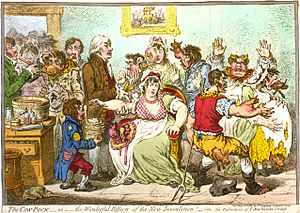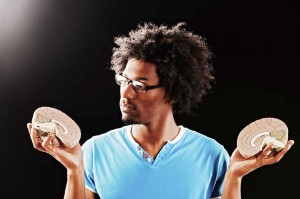Inverting The Benefits Ladder

Enjoying my benefits.
I’ve just passed a major birthday, which qualifies me for a number of government benefits, including social security and health care. While I appreciate the benefits, I also have to wonder: why do so many government benefits go to old people as opposed to young people?
The benefit system helps people – like me – who have already had plenty of opportunities. I’ve had years to work and save money for my retirement. I know that not everyone has had the same opportunities. I worked hard but I also got lucky. I know that many other people weren’t so lucky.
And that’s my point. Instead of paying people after they’ve retired, let’s invert the benefits ladder and invest in people from the beginning. Here’s an analogy – we’re all given small boats at birth. By chance, I got a boat that’s well built and seaworthy. My friend, Chuck, on the other hand, got an unstable, leaky boat. Chuck’s out at sea when his boat starts to sink. That’s OK – as long as he can swim to shore, we’ll give him a pension that will keep him alive.
Wouldn’t it be better to spend the money up front and get Chuck a boat that’s as seaworthy as mine? Note that this doesn’t ensure that Chuck will be successful. He might still get swamped. Luck will still play a role in Chuck’s life. But we’ve shifted the odds. Chuck has a better chance to succeed but he still needs to work hard.
Here’s how an inverted plan might work. When a child is born – let’s call her Susie — she automatically gets a bank account. Each year, the government puts, oh say, $10,000 in it. No one can touch the money until Susie turns 18. She then has $180,000, which she can use to start a business, go to college, learn a trade, or be a ski bum. It’s up to her. She can ask her parents for advice or not – it’s her money.
The government then says, in effect, “OK Susie, we helped you get off to a good start – now it’s up to you.” The government might offer some savings plans – somewhat like social security – but they’re voluntary. Susie is now launched. She has to make her own choices and take responsibility for her own welfare. She has every incentive to work hard and invest wisely.
I’m attracted to an inverted plan because it touches on so many American values. We say that all men (and women) are created equal. The inverted plan gets us all off on equal footing regardless of the accidents of birth. We’re also an individualistic culture and admire people who pull themselves up by their own bootstraps. The inverted plan gives people better bootstraps and the incentive to pull hard.
The plan also helps us resolve difficult issues about who deserves help. We’re a generous country. Indeed, according to the World Giving Index, America is the most charitable country in the world. But we like to give to those who are deserving. Deciding who deserves help is a thorny question that gets tangled up in questions of age, gender, social class, geography, ethnicity and so on. It also leads to never-ending debates about the “safety net” that may or may not have turned into a “…hammock that lulls able-bodied people to lives of dependency and complacency…”
My plan resolves the questions of the “deserving poor” – we simply agree that all children are deserving. Grown-ups, on the other hand, can take care of themselves. All we need to do is to protect them against the failure to launch.
So, I suggest that we consider an inverted plan. Let me know what you think. In the meantime, I’ll be lying in a hammock enjoying my government benefits.
Observation and Innovation

Don’t be cowed.
In the mid-1790s, an English country doctor named Edward Jenner made a rather routine observation: milkmaids don’t get smallpox. Milkmaids were often exposed to cowpox, a disease that’s related to smallpox but much less deadly. Cowpox gave the milkmaids flu-like symptoms that were distressing but certainly not lethal. Jenner guessed that the cowpox also conferred immunity to smallpox.
Jenner wasn’t the first to observe the cowpox effect but he was the first in the western world to act on his hunch. He created a vaccine from the scraping of cowpox pustules and administered it to some two-dozen people. They all acquired the immunity to smallpox. Jenner conducted experiments to demonstrate the treatment’s efficacy as well as the biological mechanisms in play. As a result, he is often described as the father of modern immunology.
Jenner’s breakthrough came from simple observation. He paid close attention to the world around him, observed an anomaly, and acted on it. Observation provides a foundation for both critical thinking and innovation. If necessity is the mother of invention, then observation is the grandmother. One has to observe the necessity in order to address it. (If a necessity happens in the forest and no one observes it, is it really necessary?)
How does one learn to be a good observer? Interestingly, most critical thinking textbooks don’t address this. Rather, they teach readers how to ask insightful, clarifying questions. That’s useful, of course, but also somewhat limited. Observation is merely a continuation of questioning by other means. Much more than questioning, observation can reveal fundamental insights that produce important innovations – like Jenner’s.
How does one become a good observer? Here are some thoughts I’ve gleaned from reading and from my own experience.
Pay attention – this may seem obvious but it’s hard to do. We’ve all had the experience of driving somewhere and not remembering how we got there. The mind wanders. What to do? Remind yourself to stay in the moment. Make mental notes. Ask yourself why questions. Mindfulness training may help.
Keep a journal – you can’t observe everything a given moment. Observations grow and change over time. You may have half a good idea today. The other half may not occur to you for years. Steve Johnson calls it a slow hunch. The trick to a slow hunch is remembering the first half. If it’s written down, it’s much easier to recall. (Indeed, one of the reasons I write this blog is to remember what I’ve learned).
Slow down – it’s much easier to think clearly and observe effectively if you take your time. The pace of change may well be accelerating but accelerating your thinking is not going to help you.
Pay attention to System 1 – your fast, automatic system knows what the world is supposed to be like. It can alert you to anomalies that System 2 doesn’t recognize.
Enhance your chance by broadening your horizons – Pasteur said, “Chance favors only the prepared mind.” You can prepare your mind by reading widely and by interacting with people who have completely different experiences than yours. Diversity counts.
Look for problems/listen to complaints – if a person is having a problem with something, it creates an opportunity to fix it.
Test your hypothesis – in other words, do something. Your hypothesis may be wrong but you’ll almost certainly learn something by testing it.
Observing is not always easy but it is a skill that can be learned. Many of the people we call geniuses are often superb observers more than anything else. Like Edward Jenner.
Postscript – Jenner inoculated his first patient in May 1796. Once Jenner showed its efficacy, the treatment spread quickly. So did opposition to it. In 1802, James Gillray, a popular English caricaturist, created the illustration above. Opponents claimed that cows would grow out of the bodies of people who received cowpox vaccines. Anti-vaccine agitation has been entwined with public health initiatives since the very beginning.
Two Brains. So What?

Alas, poor System 1…
We have two different thinking systems in our brain, often called System 1 and System 2. System 1 is fast and automatic and makes up to 95% of our decisions. System 2 is a slow energy hog that allows us to think through issues consciously. When we think of thinking, we’re thinking of System 2.
You might ask: Why would this matter to anyone other than neuroscientists? It’s interesting to know but does it have any practical impact? Well, here are some things that we might want to change based on the dual-brain idea.
Economic theory – our classic economic theories depend on the notion of rational people making rational decisions. As Daniel Kahneman points out, that’s not the way the world works. For instance, our loss aversion bias pushes us towards non-rational investment decisions. (See also here). It happens all the time and has created a whole new school of thought called behavioral economics (and a Nobel prize for Kahneman).
Intelligence testing – System 1 makes up to 95% of our decisions but our classic IQ tests focus exclusively on System 2. That doesn’t make sense. We need new tests that incorporate rationality as well as intelligence.
Advertising – we often measure the effectiveness of advertising through awareness tests. Yet System 1 operates below the threshold of awareness. We can know things without knowing that we know them. As Peter Steidl points out, if we make 95% of our decisions in System 1, doesn’t it also follow that we make (roughly) 95% of our purchase decisions in System 1? Branding should focus on our habits and memory rather than our awareness.
Habits (both good and bad) – we know that we shouldn’t procrastinate (or smoke or eat too much, etc.). We know that in System 2, our conscious self. But System 2 doesn’t control our habits; System 1 does. In fact, John Arden calls System 1 the habitual brain. If we want to change our bad habits (or reinforce our goods ones), we need to change the habits and rules stored in System 1. How do we do that? Largely by changing our memories.
Judgment, probability, and public policy – As Daniel Kahneman points out, humans are naturally good at grammar but awful at statistics. We create our mental models in System 1, not System 2. How frequently does something happen? We estimate probability based on how easy it is to retrieve memories. What kinds of memories are easy to retrieve? Any memory that’s especially vivid or scary. Thus, we overestimate the probability of violent crime and underestimate the probability of good deeds. We make policy decisions and public investments based on erroneous – but deeply held – predictions.
Less logic, louder voice – people who aren’t very good at something tend to overestimate their skills. It’s the Dunning-Kruger effect – people don’t recognize their own ineptitude. It’s an artifact of System 1. Experts will often craft their conclusions very carefully with many caveats and warnings. Non-experts don’t know that their expertise is limited; they simply assume that they’re right. Thus, they often speak more loudly. It’s the old saying: “He’s seldom right but never in doubt”.
Teaching critical thinking – I’ve read nearly two-dozen textbooks on critical thinking. None of them give more than a passing remark or two on the essential differences between System 1 and System 2. They focus exclusively on our conscious selves: System 2. In other words, they focus on how we make five per cent of our decisions. It’s time to re-think the way we teach thinking.
Facts Behaving Badly

One building or two?
A fact is a fact is a fact. Isn’t it? Well … not so fast.
Let’s think of a simple fact … like the number of rooms in a building. That seems factual, doesn’t it? It’s observable, verifiable, reliable, and objective. Multiple, independent observers should come to the same conclusion. If John says it’s X, Mary can verify his work by counting again. Further, it doesn’t change over time. Today’s answer should be the same as tomorrow’s. Additionally, it’s not subjective; it doesn’t depend on your mood. It’s objective – it exists in the real world, not just inside your head.
That’s what you may think but it’s actually a bit more complicated. I often run an experiment in my classes and workshops that shows how difficult it can be to pin down a fact.
I start by asking for three volunteers. My instructions are simple: “I want you to answer the question: how many rooms are on this floor of this building?” If they ask questions, I say, in a slightly superior voice, “This is a simple exercise. There’s no need to ask questions. Don’t make it more complicated than it is. Just go and do it.” (Did you ever have a boss that did this to you?)
Then I send the volunteers out one at a time to count the rooms. Each one is instructed to count the number of rooms, write the number on a piece of paper, give the paper to me, and tell no one else the number.
I collect the three answers and compare them for the class. The three answers are never the same. In fact, they often vary by a factor of two. One person may count 24 rooms; another counts 48. Occasionally, I’ll find that two answers are the same but, if so, the third is usually quite a bit different.
How do we account for this? Two thoughts come to mind. First, the exercise contains three different concepts that need to be defined: room, floor, and building. What is a room? Does a janitor’s closet count? A bathroom? What’s a floor in this sense? What if you’re in split-level building? And what’s a building? What if two buildings are joined together, as is the building where I teach at the University of Denver?
Second, this helps to illustrate how reality is an internal concept. Each volunteer has a model of reality in her head. But the models are different. In some sense, there is no external, verifiable reality. We just build models and your model is different from mine. The result? Endless confusion and controversy. Moral: be careful with your facts.
How We Think And What It Means

Let’s think about this.
We have not one but two thinking systems in our heads. Daniel Kahneman, a Nobel laureate in economics, dubs them System 1 and System 2. System 1 is fast, automatic, energy efficient, subconscious, and always on. We don’t think about it; it thinks for us. Some observers claim that System 1 makes 95% of our decisions. We merrily mosey along, not even aware that we’re making decisions.
We are, on the other hand, aware of System 2. When we think about thinking, we’re thinking about System 2. It’s our conscious self. It’s where we consider ideas, weigh evidence, and reach conclusions. Unfortunately, System 2 is an energy hog so we use it sparingly. Like other forms of exercise, System 2 requires effort, practice, and discipline. It’s hard.
We get by most of the time on System 1. Usually that’s fine – System 1 makes a lot of good decisions. But not all the time. System 1 produces biases like stereotyping, temporizing, risk aversion, and unbridled fear. If we don’t have an effective, well-tuned System 2 to overcome those biases, we can do a lot of damage to ourselves and others.
Maria Konnikova (pictured), in her lovely book, Mastermind: How To Think Like Sherlock Holmes, compares System 1 to Watson and System 2 to Holmes. System Watson represents “…our naïve selves, operating by the lazy thought habits … that we’ve spent our whole lives acquiring….” On the other hand, System Holmes, represents “… our aspirational selves, the selves that we’ll be once we’re done learning how to apply his method of thinking to our everyday lives and, in so doing break the habits of our Watson system once and for all.”
System Watson comes to us naturally. System Holmes needs to be learned, practiced, and mastered. As Konnikova notes, “…to break from that autopiloted [Watson] mode, we have to be motivated to think in a mindful, present fashion, to exert effort on what goes through our heads instead of going with the flow.”
David Brooks, in the Social Animal: The Hidden Sources of Love, Character, and Achievement, describes our bias towards the conscious mind (System 2): “The conscious mind writes the autobiography of our species. Unaware of what is going on deep down inside, the conscious mind assigns itself the starring role. It gives itself credit for performing all sorts of tasks it doesn’t really control.”
Brooks compares the conscious mind to ”… a general atop a platform, who sees the world from a distance and analyzes things linearly and linguistically….” The unconscious mind, “…is like a million little scouts [that] … careen across the landscape, sending back a constant flow of signals and generating instant responses. They maintain no distance from the environment, but are immersed in it. They scurry about, interpenetrating other minds, landscapes, and ideas.”
For Brooks, the individual is the star in the “outer mind”. In contrast, “… the inner mind highlights the power of relationships and the invisible bonds between people. If the outer mind hungers for status, money, and applause, the inner mind hungers for harmony and connection….”
From Kahneman, we learn about the native biases of System 1 and an important implication: we’re not rational when it comes to economic matters. This is the insight that won the Nobel Prize. From Konnikova, we learn how to observe and deduce. The implication: with sufficient motivation, we can indeed learn to overcome our biases. From Brooks, we learn that System 2 is an individualist while System 1 is a collectivist. The implication: this duality is an important source of tension in the body politic.
What else can we learn by comparing System 1 to System 2? Let’s talk more about that tomorrow.